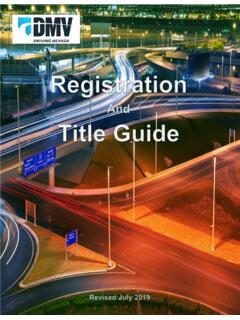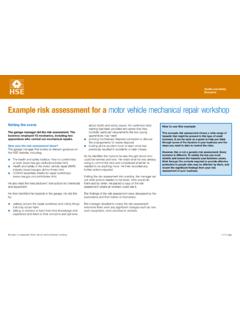Transcription of BORON STEEL IN VEHICLES
1 BORON STEEL IN VEHICLES Implications of HSLA/UHSS and BORON Steels for Rescuers by Len Watson An informative report for discussion and study - This report has been produced in Adobe portable document format (pdf) and can be downloaded and saved. It has been secured to prevent unsolicited changes and published on the net for your safety and for the purpose of sharing information to stimulate interest and invite comment from Rescue professionals. Within Adobe Professional 6 or later the facility exists for notes to be made and placed on the document wherever the reader considers appropriate and can be saved when closing the document. Simply right click the mouse and select the available tool/option you wish to use. In the interest of sharing information we would ask the reader to consider sharing their views and comments with other Rescue professionals.
2 To send your comments to us, simply follow the instructions and attach your notes file using the Reply icon at the end of this document. We at resQmed will respect your confidence and will only ever release information on our study site with your permission. For further information on the Note facility, click on the note icon - CONTENTS vehicle extrication rescue and BORON STEEL + Applications Cutting BORON STEEL vehicle extrication rescue The problems that are mainly experienced The different performance of blade configurations sported by cutters BORON STEEL reclining seat-brackets The dash cross-member Final comment Further reading and send comment BORON STEEL IN VEHICLES Document for discussion Last revised August 2008 vehicle Extrication Rescue and BORON STEEL The type of BORON STEEL used on VEHICLES today has extremely high strength.
3 BORON STEEL can have a yield point of about 1,350 1,400 N/mm2 (196,000 203,000 psi). That s about four times stronger than average high-strength STEEL . But the process used to make it that strong takes away some of the STEEL s workability properties, such as being able to cut it. BORON STEEL Applications With new vehicle safety legislation and increased fuel prices, automotive manufacturers have responded with greater car body stiffness and lower body weight for both safety and fuel efficiency. The fields of materials development, engineering, and manufacturing have been working together to achieve these goals. Advanced steels, new forming processes, and new press concepts have been adopted to achieve weight reduction with improved crash worthiness. The introduction of BORON STEEL was found primarily on European VEHICLES (dash cross-member on the 2002 Porsche Cayenne SUV, the safety bar around the rear seats on the 2003 Porsche Boxster, door strengthening beams on the 2003 Porsche 911 Carrera, and the inner centre pillars on the 2003 Mercedes-Benz E Class).
4 Volvo probably uses BORON STEEL the most (On bumper reinforcements, door strengthening beams and seat recliner brackets on the 2004 Volvo S40 sedan and 2005 V50 station wagon). The 2003 Volvo XC90 SUV has additional applications of BORON STEEL , in the windscreen pillars and gussets in the centre pillars where they meet with the roof side channel and sill and as rear body panels. Globally most vehicle manufactures feature BORON STEEL in their 2004 model range in some form or another. Strengthening bars, gussets and plates The application of BORON STEEL to strengthen the weaker areas of the motor vehicle is obviously, for the motor industry that is, the correct path for them to take. However, in an ever-growing safety conscious environment, where we now see the inclusion of many new safety features, we must study the available statistics to analyse the end results.
5 Recent outcomes should bear out the assumption that the car-user fatality rate has been reduced significantly in recent years and where it has, it is essential that what really lies behind the reduction is identified. Where new innovation cannot realistically be accredited with the reduction we must ask ourselves, why not?. Many of the statistics available have been massaged to show degrees of success, where a wider range of issues could be introduced to question these outcomes. To gain a wider concept of what this actually means See SRS another perspective - which will introduce the reader to a wider analytic area of airbag technology that has been purposefully overlooked. Not only are there many other new steels all with differing strengths, there are also many new coatings which the STEEL has been treated with. Coatings such as Zinc, Bonazinc, Granocoating, aluminated sheet metals etc.
6 This all adds to the confusion over the steels. USIBOR-BTR- BORON are all the same grade of STEEL , just with a different name, depending which country it comes from. It is very strong but light in weight. In general it is used to provide extra strength in the sill area, roof and centre posts, chassis areas, door strengthening bars, dash cross-members and roll over bars. It could be called the most ultra of the ultra-high-strength steels. BORON STEEL may be a dream material for vehicle makers, but to the collision industry it can be challenging. To some collision repair technicians who have called the I-CAR Tech Centre, working with and BORON STEEL does not seem to go hand-in-hand. BORON STEEL can be worked with, short of straightening, it can be welded just like any other STEEL , and it can be cut if the right tools are used. However the motor industry has once again totally overlooked the Rescue profession The type of BORON STEEL used on VEHICLES today has extremely high strength.
7 The BORON STEEL used on Volvo cars has a yield point of about 1,350 1,400 N/mm2 (196,000 203,000 psi). That s about four times stronger than average high-strength STEEL . But the process used to make it that strong takes away some of the STEEL s workability properties, such as being able to straighten it. Cutting BORON STEEL vehicle extrication rescue: Volvo recommend that the garage repair trade cut BORON STEEL with a disc cutter or a plasma-arc torch, both of which are not suitable for Rescue. The reciprocating saw is next to useless on BORON STEEL and would take far too long. It will remove the teeth on the saw's blade very quickly when sawing and requires many blade changes. The older hydraulic cutter will also prove fruitless. Newer up-rated cutters with a cutting force in excess of 40 ton/es (40>kN force), have sufficient power to cut HSLA (high strength low alloy) steels but will struggle with UHSLA (Ultra high strength low alloy) steels, especially where the channel contain multi layers.
8 The problems that are mainly experienced: when trying to cut the base of the centre post on cars equipped with BORON it will be found that 40 ton (350 kN approx) cutters are simply not up to the job. Manufacturers claims for some of their cutters are somewhat misleading as they intimate that all their cutters are capable of cutting all UHSLA and BORON steels (AHSS- Advanced high strength STEEL ). Many cutters have nowhere near the capacity, especially those that only generate a maximum of 30,000 lbs (130 kN approx) at the centre of the blades. As you know the stock cutting notch measurement of force has little bearing when making these cuts as the stock will not butt up against the BORON within the metal channel that needs to be cut. This is the main area of confusion. Cutter are often demonstrated cutting sections of BORON STEEL and BORON bar where the cutter blades totally encircle the cut and the full force of the tool comes into play.
9 Of course this does not represent the real world; where the tips of the blades (where the cutting force is least) fail to puncture the larger cross-sectional area at the base of the centre post, the cut cannot be completed. Many rescue tool manufacturers display their cutters shearing through strengthening bars and HSLA channel with BORON STEEL bar inserts. Be aware of the cross sectional area in respect of the cut. Where the channel is small it will butt up against the stock where the tool has the most cutting force. This display of the cutters ability is not a true indication of what is actually required. Subaru WRX 2004 top of centre post The large cross-sectional area at the base of the centre post is quite a different matter. Many cutters available on the market just do not have the power to complete the cuts to the base of the centre post on many VEHICLES incorporating BORON STEEL inserts.
10 This problem can only increase with greater strength BORON inclusions in new vehicle design. With the introduction of the Volvo X90 in 2002, tool manufacturers were invited to test their equipment. At that time most manufacturers cutters professed in the region of 40 ton (350 kN approx) cutting forces at the stock but, without exception, all cutters tested failed to cut the base of the centre post. It was for this reason that most manufacturers upgraded their tools, up to and above 90 ton (800 kN approx) cutting capacity. That was then and of course we must now appreciate that the motor industry has moved on and that tool manufacturers are committed to staying abreast of the situation. Even so, tool companies can only ever hope to measure their tools against a small proportion of new VEHICLES and then, only when invited to do so or where VEHICLES are donated by a motor manufacturer.




